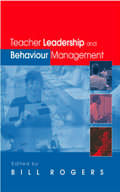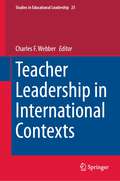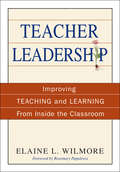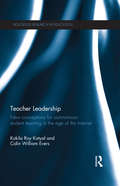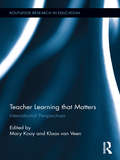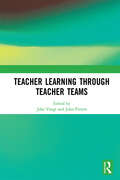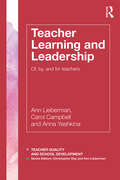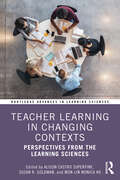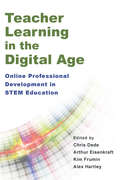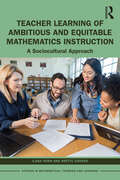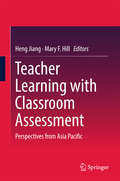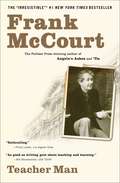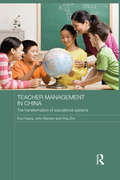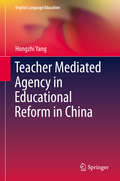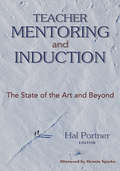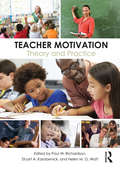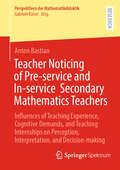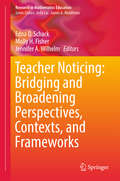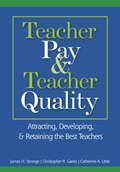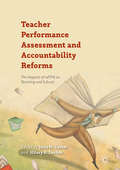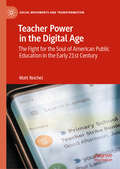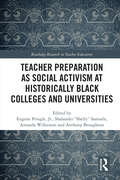- Table View
- List View
Teacher Leadership and Behaviour Management
by Bill RogersIn framing this book, Bill Rogers discusses `what changes′ and `what stays the same′ in teacher leadership and behaviour. Original chapters from well-known writers and practitioners set out current approaches in behaviour leadership, in terms of practical concerns about behaviour management and discipline. The emphasis on teacher leadership is intentional, as the authors believe that the kind of teacher leadership in a school significantly affects the effectiveness and humanity of discipline and management. All the contributors have a teaching background and all are directly involved with schools, in research and consultancy. Bill Rogers works in classrooms with teachers, as a coach/mentor. Each chapter demonstrates a commitment to support classroom teachers with practical action research in areas such as: - Teacher leadership - Effective teaching - Colleague support - Discipline and behaviour management - Working with students who show emotional-behavioural disorders. This book will be useful to teachers and other education professionals interested in behaviour management, discipline and colleague support issues.
Teacher Leadership in International Contexts (Studies in Educational Leadership #25)
by Charles F. WebberThis book addresses the critical gaps among understandings of teacher leadership across organizational and cultural contexts. It challenges the use of the term teacher leadership as if there is a widely shared understanding of what it is and what it means for exercising influence and making decisions. The book describes how implicit meanings and competing assumptions about teacher leadership may contribute to uncertainty and confusion in school communities. The authors caution against the incorporation of teacher leadership in international policy making discussions without adequate consideration of contextual, organizational, historical, and cultural differences that may lead to school community members struggling to accommodate the concept or, worse, ignoring other frameworks for facilitating more culturally appropriate decision making. This book shares the findings of research conducted in several North American, European, African, Latin-American, and Australasian contexts as part of the International Study of Teacher Leadership. Study findings are used to posit contextualized conceptualizations of teacher leadership and to offer a perspective for positioning researchers and practitioners in the international teacher leadership discourse.
Teacher Leadership: Improving Teaching and Learning From Inside the Classroom
by Elaine L. WilmoreWilmore integrates school reform research with strategies for increasing classroom leadership capacity and offers a global perspective on classroom teachers' participation as leaders of students and schools.
Teacher Leadership: New conceptions for autonomous student learning in the age of the Internet (Routledge Research in Education)
by Kokila Roy Katyal Colin William EversIn recent years teacher leadership has undergone one major revolution and is in the process of undergoing another. The first came about as schools turned out to be far too complex for the responsibility of formulating and achieving their goals to be vested entirely in principals and head teachers. As a consequence, the rise of distributed leadership as an alternative model for understanding schools and their functioning is now commonplace. The second major revolution affecting teacher leadership is the rise of the Internet and ICT, and the way these give rise to greater and more flexible opportunities for students to become autonomous learners. Autonomous student learning now occurs in significant new ways and under parameters that are far more expansive than school-based learning. An effective model of teacher leadership thus needs to capture these changes in order to reflect the new realities of student learning and student engagement with their schools.
Teacher Learning That Matters: International Perspectives (Routledge Research in Education)
by Mary Kooy Klaas Van VeenIn the continuing global call for educational reforms and change, the contributors in this edited collection address the critical issue of teacher learning from diverse national contexts and perspectives. They define "teacher learning that matters" as it shapes and directs pedagogical practices with the goal of improving student learning. Student achievement is broadly and inclusively defined, beyond the test scores so often identified as the mark of “success” in the research literature. This book weaves together major studies, research findings and theoretical orientations to represent a globalized network of inquiries into the what, how and why of teacher learning that shapes teacher skill and knowledge. Teacher learning matters on an international scale because teachers are the portals through which any initiative for change and reform is realized. Recognizing that a highly skilled teaching force is instrumental to improving student achievement adds import to generating interactive dialogue on teacher learning around the globe.
Teacher Learning Through Teacher Teams
by Joke Voogt Jules PietersTeacher collaboration helps to facilitate meaningful and effective learning and enables sustainable development of schools. Teacher teams who collaboratively investigate a shared problem, or design curriculum materials together, significantly contribute to the professional development of teachers in areas of subject matter, curriculum design and data skills. Contributions to this book discuss various perspectives of teachers collaborating in design teams, by investigating the sense of collaboration and its effects, and the conditions that influence and drive it. The studies provided suggest that collaborative design and research supports participants (teachers and teacher educators) to improve their knowledge, specifically in regards to technological pedagogical content and subject matter. Participating teachers further developed curriculum design expertise, such as, understanding the relevance and effectiveness of involving stakeholders in designing and implementing newly designed curricula. This volume was originally published as a special issue of Educational Research and Evaluation.
Teacher Learning and Leadership: Of, By, and For Teachers (Teacher Quality and School Development)
by Ann Lieberman Carol Campbell Anna YashkinaTeacher Learning and Leadership asserts that teachers should be put at the center of creating, developing, organizing, implementing, and sharing their own ideas for school change rather than being passive recipients of knowledge from the outside. It argues that there is tremendous potential for the good of students and the professionalization of teaching, when teachers work collaboratively to develop their own and their colleagues’ professional knowledge and practices and are supported by school and system leaders, unions and government. The book draws on the groundbreaking work of the Teacher Learning and Leadership Program in Ontario and uses an in-depth case study to illustrate its points. It demonstrates how professional development built around collaboration, teacher leadership, curriculum development, technology and pedagogy can be organized in a way that redistributes control and responsibility to teachers, thereby instilling a genuine sense of pride and accomplishment in their work. This book is a sincere outreach from the authors who advocate for the professional development of, by and for teachers as individuals and, importantly, as a collective profession. The authors argue that projects like the TLLP (a joint initiative between the Ontario Ministry of Education and the Ontario Teachers’ Federation) can radically, and positively, transform teachers’ knowledge, skills and practices. The book provides an important model for school change led by teachers, rather than experts, in partnership with school and system leaders and is a fascinating read for all those concerned with teaching, teacher development and educational change.
Teacher Learning in Changing Contexts: Perspectives from the Learning Sciences (Routledge Advances in Learning Sciences)
by Susan R. Goldman Alison Castro Superfine Monica Ko, Mon-LinNew to the Routledge Advances in Learning Sciences series, this book highlights diverse approaches taken by researchers in the Learning Sciences to support teacher learning. It features international perspectives from world class researchers that exemplify new lenses on the work of teaching, encompassing new objects of learning, methods and tools; new ways of working with researchers and peers; and new efforts to work with the systems in which teachers are embedded. Together, the chapters in this volume reflect a new frontier of research on teacher learning that leverages diversity in the content, contexts, objects of inquiry, and tools for supporting shifts in instructional practice. Divided into three sections, chapters question: What new pedagogies and knowledge do teachers need to facilitate student learning in the 21st century? How do learning sciences’ tools, strategies, and experiences provide opportunities for them to learn these? What role do teachers play as co-designers of educational innovations? What unique affordances does co-design afford for teacher learning? What do teachers learn through engaging in co-design? How do teachers work and learn as part of interdisciplinary teams within educational systems? What might it look like to design for teacher learning in these broader organizational systems? Uniquely highlighting how cycles of reflection and co-design can serve as important mechanisms to support teacher learning, this invaluable book lays the groundwork for sustained teacher learning and instructional improvement.
Teacher Learning in the Digital Age: Online Professional Development in STEM Education
by Arthur Eisenkraft Chris Dede Kim Frumin Alex HartleyWith an emphasis on science, technology, engineering, and mathematics (STEM) training, Teacher Learning in the Digital Age examines exemplary models of online and blended teacher professional development, including information on the structure and design of each model, intended audience, and existing research and evaluation data. From video-based courses to just-in-time curriculum support platforms and MOOCs for educators, the cutting-edge initiatives described in these chapters illustrate the broad range of innovative programs that have emerged to support preservice and in-service teachers in formal and informal settings. "As teacher development moves online," the editors argue, "it's important to ask what works and what doesn't and for whom," They address these questions by gathering the feedback of many of the top researchers, developers, and providers working in the field today. Filled with abundant resources, Teacher Learning in the Digital Age reveals critical lessons and insights for designers, researchers, and educators in search of the most efficient and effective ways to leverage technology to support formal, as well as informal, teacher learning. "Teacher Learning in the Digital Age is a superb compilation of exemplary instructional practices utilizing digital resources. This thoughtful and practical body of work can be leveraged to propel teacher and student success in the evolution of the digital classroom and school." --Mark Edwards, superintendent, Mooresville Graded School District, North Carolina
Teacher Learning in the Digital Age: Online Professional Development in STEM Education
by Chris Dede, Arthur Eisenkraft, Kim Frumin and Alex HartleyWith an emphasis on science, technology, engineering, and mathematics (STEM) training, Teacher Learning in the Digital Age examines exemplary models of online and blended teacher professional development, including information on the structure and design of each model, intended audience, and existing research and evaluation data. From video-based courses to just-in-time curriculum support platforms and MOOCs for educators, the cutting-edge initiatives described in these chapters illustrate the broad range of innovative programs that have emerged to support preservice and in-service teachers in formal and informal settings. &“As teacher development moves online,&” the editors argue, &“it&’s important to ask what works and what doesn&’t and for whom,&” They address these questions by gathering the feedback of many of the top researchers, developers, and providers working in the field today. Filled with abundant resources, Teacher Learning in the Digital Age reveals critical lessons and insights for designers, researchers, and educators in search of the most efficient and effective ways to leverage technology to support formal, as well as informal, teacher learning.
Teacher Learning of Ambitious and Equitable Mathematics Instruction: A Sociocultural Approach (Studies in Mathematical Thinking and Learning Series)
by Ilana Horn Brette GarnerDrawing on sociocultural learning theory, this book offers a groundbreaking theory of secondary mathematics teacher learning in schools, focusing on the transformation of instruction as a conceptual change project to achieve ambitious and equitable mathematics teaching. Despite decades of research showing the importance of ambitious and equitable teaching, few inroads have been made in most U.S. classrooms, and teacher learning in general remains undertheorized in most educational research. Illustrating their theory through closely documented case studies of secondary mathematics teachers’ learning and instructional practices, authors Horn and Garner explore the key conceptual issues teachers are required to work through in order to more fully realize ambitious and equitable teaching in their classrooms. By theorizing teacher learning from a sociocultural perspective and focusing on instructional practice, the authors make a unique contribution to the field of teacher learning. This book offers researchers, scholars, and teacher educators new theoretical and methodological tools for the elusive phenomenon of teacher learning, and provides instructional leaders and coaches with practical examples of how teachers shift their thinking and practice.
Teacher Learning of Ambitious and Equitable Mathematics Instruction: A Sociocultural Approach (Studies in Mathematical Thinking and Learning Series)
by Ilana Horn Brette GarnerDrawing on sociocultural learning theory, this book offers a groundbreaking theory of secondary mathematics teacher learning in schools, focusing on the transformation of instruction as a conceptual change project to achieve ambitious and equitable mathematics teaching.Despite decades of research showing the importance of ambitious and equitable teaching, few inroads have been made in most U.S. classrooms, and teacher learning in general remains undertheorized in most educational research. Illustrating their theory through closely documented case studies of secondary mathematics teachers’ learning and instructional practices, authors Horn and Garner explore the key conceptual issues teachers are required to work through in order to more fully realize ambitious and equitable teaching in their classrooms. By theorizing teacher learning from a sociocultural perspective and focusing on instructional practice, the authors make a unique contribution to the field of teacher learning.This book offers researchers, scholars, and teacher educators new theoretical and methodological tools for the elusive phenomenon of teacher learning, and provides instructional leaders and coaches with practical examples of how teachers shift their thinking and practice.
Teacher Learning with Classroom Assessment: Perspectives From Asia Pacific
by Heng Jiang Mary F. HillThis book discusses the interwoven themes of teacher learning and classroom assessment, highlighting the complexity and intricacy of these processes in a range of very different classroom contexts. The case studies demonstrate how classroom assessment is needed for teachers to learn about teaching and for them to be able to grow professionally and improve student learning. Although this volume is mainly situated in the unique and varied contexts of the Asia-Pacific region, it addresses the key issues of quality teaching, assessment, and accountability in a global context.
Teacher Man: A Memoir (The Frank McCourt Memoirs)
by Frank McCourtNearly a decade ago Frank McCourt became an unlikely star when, at the age of sixty-six, he burst onto the literary scene with Angela's Ashes, the Pulitzer Prize -- winning memoir of his childhood in Limerick, Ireland. Then came 'Tis, his glorious account of his early years in New York. Now, here at last, is McCourt's long-awaited book about how his thirty-year teaching career shaped his second act as a writer. Teacher Man is also an urgent tribute to teachers everywhere. In bold and spirited prose featuring his irreverent wit and heartbreaking honesty, McCourt records the trials, triumphs and surprises he faces in public high schools around New York City. His methods anything but conventional, McCourt creates a lasting impact on his students through imaginative assignments (he instructs one class to write "An Excuse Note from Adam or Eve to God"), singalongs (featuring recipe ingredients as lyrics), and field trips (imagine taking twenty-nine rowdy girls to a movie in Times Square!). McCourt struggles to find his way in the classroom and spends his evenings drinking with writers and dreaming of one day putting his own story to paper. Teacher Man shows McCourt developing his unparalleled ability to tell a great story as, five days a week, five periods per day, he works to gain the attention and respect of unruly, hormonally charged or indifferent adolescents. McCourt's rocky marriage, his failed attempt to get a Ph.D. at Trinity College, Dublin, and his repeated firings due to his propensity to talk back to his superiors ironically lead him to New York's most prestigious school, Stuyvesant High School, where he finally finds a place and a voice. "Doggedness," he says, is "not as glamorous as ambition or talent or intellect or charm, but still the one thing that got me through the days and nights." For McCourt, storytelling itself is the source of salvation, and in Teacher Man the journey to redemption -- and literary fame -- is an exhilarating adventure.
Teacher Management in China: The Transformation of Educational Systems (Routledge Contemporary China Series)
by John Benson Ying Zhu Eva HuangEducation has long been highly valued in China, and continues to be highly valued, both by the state, which appreciates the value of education for maintaining China's economic rise, and by parents, who, affected by the One Child Policy, devote a large proportion of their incomes to their one child's education. This book explores current systems of teacher management in China and assesses their effectiveness. It charts the development of China's education system, outlines present day human resource management methods in Chinese schools, including practices for recruitment and selection, training and development, performance appraisal, and rewards, both pay and non-financial rewards, and describes recent changes and innovations. The book concludes that a high performance work system, enhanced by traditional paternalistic humanised management and by pragmatism, predominates, with important consequences for teachers’ jobs and performance, and for the quality of students' school life.
Teacher Mediated Agency in Educational Reform in China
by Hongzhi YangThis book examines teacher agency in implementing English as a Foreign Language (EFL) curriculum reform in the Chinese university context. It theorizes the concept of teacher agency from a sociocultural theory perspective and draws on a study conducted in a conservative and less developed area in China. The book uses Engeström's activity theory and Vygotsky's concept of the Zone of Proximal Development (ZPD) to understand the nature and extent of teacher agency in adapting one's teaching with respect to beliefs, knowledge and instructional practices. The study concludes that curriculum reform in China needs to shift from reliance on 'top-down' policies to 'bottom-up' implementation that mobilizes local understandings and practices. One of the implications of this study is that transformative teacher education programs aimed at developing teacher pedagogical agency require that teachers have ongoing opportunities to design, develop and evaluate curriculum-based mediational means.
Teacher Mentoring and Induction: The State of the Art and Beyond
by Mr Hal PortnerIn this groundbreaking work, Harry K. Wong, Laura Lipton, Bruce Wellman, and other top names in the field examine how successful mentoring and induction programs are developed and demonstrate how they can be replicated.
Teacher Motivation: Theory and Practice
by Paul W. Richardson Stuart A. Karabenick Helen M. G. WattTeacher Motivation: Theory and Practice provides a much needed introduction to the current status and future directions of theory and research on teacher motivation. Although there is a robust literature covering the theory and research on student motivation, until recently there has been comparatively little attention paid to teachers. This volume draws together a decade of work from psychological theorists and researchers interested in what motivates people to choose teaching as a career, what motivates them as they work with students in classrooms, the impact of intrinsic and extrinsic forces on career experiences, and how their motivational profiles vary at different stages of their career. With chapters from leading experts on the topic, this volume provides a critical resource not only for educational psychologists, but also for those working in related fields such as educational leadership, teacher development, policy makers and school psychology.
Teacher Noticing of Pre-service and In-service Secondary Mathematics Teachers: Influences of Teaching Experience, Cognitive Demands, and Teaching Internships on Perception, Interpretation, and Decision-making (Perspektiven der Mathematikdidaktik)
by Anton BastianIn light of increasing demands on teachers and the need to develop teaching-related competences, this book examines the situation-specific skill of teacher noticing in pre-service and in-service secondary mathematics teachers. A video-based test instrument is used to measure teachers’ noticing skills in perception, interpretation, and decision-making from both general and mathematics pedagogical perspectives. The aim is to understand the structure and characteristics of teacher noticing across different groups, as well as the influences of teaching experience and opportunities to learn. Three quantitative studies are conducted: two cross-sectional studies with 457 participants, including master’s students, early career teachers, and experienced teachers, and one longitudinal study with 175 master’s students. The results support the conceptualization of teacher noticing as comprising three facets. They also reveal positive influences of teaching experience on the development of teacher noticing, with in-service teachers outperforming master’s students. However, experienced teachers perform similarly to early career teachers in general and worse in certain areas, suggesting saturation or forgetting effects. The longitudinal study finds that interpretation skills facilitate the development of perception and decision-making, emphasizing the knowledge-based nature of teacher noticing.
Teacher Noticing: Bridging and Broadening Perspectives, Contexts, and Frameworks
by Edna O. Schack Molly H. Fisher Jennifer A. WilhelmThis book reflects on the continuing development of teacher noticing through an exploration of the latest research. The authors and editors seek to clarify the construct of teacher noticing and its related branches and respond to challenges brought forth in earlier research. The authors also investigate teacher noticing in multiple contexts and frameworks, including mathematics, science, international venues, and various age groups.
Teacher Pay and Teacher Quality: Attracting, Developing, and Retaining the Best Teachers
by Catherine A. Little James H. Stronge Christopher R. GareisThis review of existing teacher compensation models provides school administrators with a research-based approach for developing a compensation system that attracts and retains high-quality teachers.
Teacher Pay and Teacher Quality: Attracting, Developing, and Retaining the Best Teachers
by Catherine A. Little James H. Stronge Christopher R. GareisThis review of existing teacher compensation models provides school administrators with a research-based approach for developing a compensation system that attracts and retains high-quality teachers.
Teacher Performance Assessment and Accountability Reforms
by Julie H. Carter Hilary A. LochteThis book provides multiple perspectives on the dual struggle that teacher educators currently face as they make sense of edTPA while preparing their pre-service teachers for this high stakes teacher exam. The adoption of nationalized teacher performance exams has raised concerns about the influence of corporate interests in teacher education, the objectivity of nationalized teaching standards, and ultimately the overarching political and economic interests shaping the process, format, and nature of assessment itself. Through an arc of scholarship from various perspectives, this book explores a range of questions about the goals and interests at work in the roll out of the edTPA assessment and gives voice to those most affected by these policy changes, teacher educators, and teacher education students.
Teacher Power in the Digital Age: The Fight for the Soul of American Public Education in the Early 21st Century (Social Movements and Transformation)
by Matt ReichelThis book is an examination of the confluence of social, political, and communicative forces animating the teachers&’ uprising of the last decade: beginning with the accession of a militant slate to the Chicago Teachers Union (CTU) in 2011 and continuing with myriad strikes, walkouts and other protest actions taken throughout the country since then. During this time, thousands of teachers have participated in protest actions in dozens of states and jurisdictions throughout the country, thus ending a lengthy period of relative dormancy on the part of teachers&’ unions as a political organizing force. This movement is situated amongst the other digitally-enabled &“movements of the squares&” that have occurred in recent years, including the Occupy movement and the Arab Spring, which all emerge out of the ongoing crisis of neoliberal capitalism, though this book argues that the teachers&’ movement has been central to this wave of contestation due its institutional grounding. This book will be of interest to readers with a background in Political Sociology, Education Policy, Political Communication and related fields.
Teacher Preparation as Social Activism at Historically Black Colleges and Universities (Routledge Research in Teacher Education)
by Amanda Wilkerson Eugene Pringle Jr. Shalander “Shelly” Samuels Anthony BroughtonTeacher Preparation as Social Activism at Historically Black Colleges and Universities offers new insights into the historical educational perspectives of teacher preparation at Historically Black Colleges and Universities (HBCUs).Centering insightful research that chronicles the contributions of teacher preparation at HBCUs, it has a specific focus on activism in the form of fugitive pedagogy, social activism, organizing, and inclusive educational practices. It highlights and explores the ways in which such programs developed technical pedagogical skills for teaching and learning while leveraging society as an incubator to engage students in practices necessary to destabilize oppressive systems. The chapter authors examine historical social movements at the intersection of teacher preparation at HBCUs and race to impact societal change over time and explore teacher preparation at HBCUs as tools for activism, social justice, and liberatory practices.Reimagining educational history through the context of race relations and its contributing factors to the educational ecosystem, this significant contribution to the body of research on HBCUs will appeal to scholars and researchers with interests in teacher education, history of education, race and ethnic studies, urban studies, and higher education.
